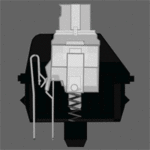Mechanical Keyboards
| Language: | English |
|---|
| Mechanical Keyboards | |

| |
| Status: | active |
| Thema: | Collecting and experimenting with mechanical switches and keycaps to find or create the ultimate keyboard. |
| Gestartet: | 04.05.2017 |
| Organisator: | Filnamos, [User:anlumo |
| Treffen: | on demand |
| Zielgruppe: | People who type regularily. |
| Inhalt: | |
| Zuletzt aktualisiert: | 2017-05-04 |
Mechanical Keyboards
Keyboards have a long tradition for text entry that dates back to the first typewriters. Even today, most computers ship with one!
Different technologies for implementing their buttons have emerged, from capacitive surfaces with no haptic feedback (except the hard surface) whatsoever to mechanical keyswitches, who go to great lengths to provide a clear feedback to the user. Between these extremes, there are membrane and dome switches, that are preferred for low-profile keyboards, such as used in most notebooks. A notable exception was developed by MSI.
However, no clear winner in keyswitch technologies has yet been developed, different people prefer different technologies for productive typing.
The Mechanical Keyboard Community
Around mechanical keyswitches, a community of enthusiasts has developed, who collect them and keyboards featuring them. Technologies around them, like keycaps and backlighting are also explored. These people like to try out different haptics, some in order to come up with their ultimate keyboard (although the personal definition of the ultimate keyboard might also be situational, for example you don't want to use a loud clicky keyboard in a library). For others, this has also become a numismatics-like obsession, so they collect various different types to get a complete collection of all the types that are available.
The Technology Behind It
A typical modern keyboard consists of the following components:
- a case
- a PCB (with diodes to avoid ghosting)
- a USB controller
- keyswitches
- keycaps
Case
Mechanical keyboards come in all types and sizes. Usually, they are denoted in percent-values of a full keyboard (with 105 keys). For example, a 60% keyboard has about 60 keys.
Usual keyboard sizes are:
- 100%
- 80%: no numpad
- 60%: no F-keys
- 40%: no number keys, no arrow keys
Missing keys are replaced by additional shift keys to have multiple functions on a single key.
Case materials are very free-form and usually dictate the way they're produced. Typical materials are (ordered by one-off costs):
- Injection-molded ABS
- Milled aluminium or other metals
- Laser-cut acrylic
- Wood: milled, laser-cut or hand-carved